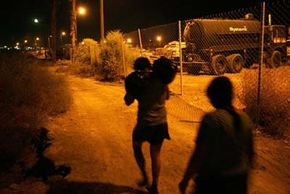Modern Migration
Migration in the modern world has one key difference from earlier forms: national borders. Borders block attempts to migrate, limit migration to certain groups or quotas and restrict migration to certain economic classes. While migration is still driven by the same basic pressures, it is now artificially shaped by political forces as well.
Most modern migration follows economic patterns. People are always seeking better economic opportunities. For decades, this lead to a migratory flow in North America of south-to-north. Northern cities had plenty of industrial jobs and were economic centers. Industrialization had been delayed in the American south and in Mexico, so people there moved north to get jobs. This exact same drive is what fuels migration from Mexico to the United States today.
Advertisement
However, beginning in the 1980s, U.S. migration started moving from north to south. The old industries that had drawn so many southerners in decades past were failing or moving due to pressures from foreign competitors. Meanwhile, cities in the south and west were capitalizing on newer technologies, opening up new industries and offering plentiful jobs. Between 1995 and 2000, the largest movement from one state to the other was from New York to Florida (source: U.S. Bureau of the Census].
In Europe, migration is following a similar pattern. Plentiful jobs in wealthy European nations are drawing an influx of immigrants from Turkey, Pakistan and other areas of the Middle East.
Migrating to Space
Where will humans migrate to next? Some suggest it is inevitable that we will someday colonize space. There are many reasons people have looked to space as the migration destination. There are resources to be exploited. There is space for people to live, increasingly an issue as the world population grows. For some, survival of the race is the imperative -- if an asteroid or nuclear war wiped out life on Earth, space colonies could carry on our culture and very existence. Some may be motivated like the Pilgrims to make a new start and create a nation that conforms to their vision of a perfect world.
A lot of work lies between us and the first true space colony. There are numerous problems to be solved, such as overcoming the long-term effects of weightlessness on humans, successfully navigating the vast distances between planets and creating the basic resources necessary for humans to live (water, air and food, specifically). Perhaps the drive that will ultimately lead us to accomplish space colonization is the intangible one we mentioned earlier -- the human spirit.
If you're interested in learning more about humans migrating and related topics, try the links below.
Related HowStuffWorks Articles
- How Population Works
- How Immigration Works
- How Food Works
- How Water Works
- How the Census Works
- How Passports Work
More Great Links
Sources
- American Studies at the University of Virginia. "Pilgrims and Puritans: Background." http://xroads.virginia.edu/~CAP/puritan/purhist.html
- Groleau, Rick. "Tracing Ancestry with MtDNA." NOVA Online. http://www.pbs.org/wgbh/nova/neanderthals/mtdna.html
- Haywood, John, Ph.D. Atlas of World History. Barnes & Noble (2001).
- Human Rights Watch. "Iraqi Refugees: Summary." http://hrw.org/backgrounder/refugees/iraq0407/1.htm#_Toc164487346
- The Institute of Arctic and Alpine Research. "Postglacial Flooding of the Bering Land Bridge: A Geospatial Animation." http://instaar.colorado.edu/QGISL/bering_land_bridge/
- Jewish Virtual Library. "The Tragedy of the S.S. St. Louis." http://www.jewishvirtuallibrary.org/jsource/Holocaust/stlouis.html
- National Geographic. The Genographic Project. http://www.nationalgeographic.com/genographic/atlas.html
- Schopf, J. William. Major Events In The History Of Life. Jones & Bartlett, (December 17, 1991).
- Smithsonian Institution. "Theories on Modern Human Origins and Diversity." http://anthropology.si.edu/humanorigins/faq/Encarta/diversity.htm#ooa
- United Nations Department of Economic and Social Affairs, Population Division. "World Urbanization Prospects: The 2005 Revision." http://www.un.org/esa/population/publications/WUP2005/2005wup.htm
- U.S. Census Bureau. "Table 2. Population of the 24 Urban Places: 1790." http://www.census.gov/population/documentation/twps0027/tab02.txt
- U.S. Census Bureau. "Table 7. Population of the 100 Largest Urban Places: 1840." http://www.census.gov/population/documentation/twps0027/tab07.txt
- U.S. Census Bureau. "Table 2. Population, Housing Units, Area Measurements, and Density: 1790 to 1990." http://www.census.gov/population/censusdata/table-2.pdf
- United States Holocaust Memorial Museum. "German-Jewish Refugees, 1933-1939." http://devdata.worldbank.org/wdipdfs/table3_10.pdf
- U.S. Census Bureau. "State-to-State Migration Flows: 1995 to 2000." http://www.census.gov/prod/2003pubs/censr-8.pdf
